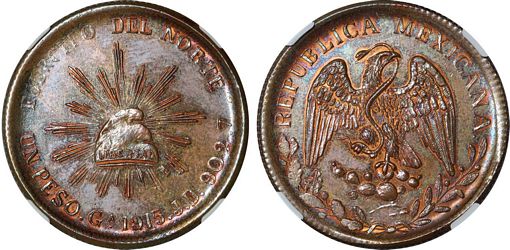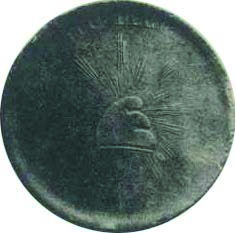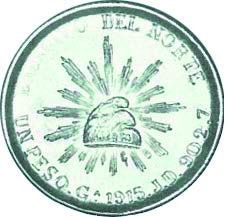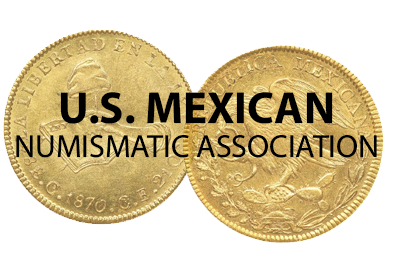“Ejército Del Norte” Peso (1914–1915) - An Extremely Rare Revolutionary Pattern
by Alejandro Martínez Bustos and Emiliano Puga Gómez

At the height of the Mexican Revolution in 1914, Guadalajara, the capital of Jalisco, was held by the Federal Army under the command of President and dictator Victoriano Huerta. The revolutionaries shared a common objective: to overthrow Huerta by reclaiming territories under his control.
A year earlier, Venustiano Carranza had declared himself “First Chief of the Constitutionalist Army” and organized seven military corps, appointing General Álvaro Obregón to command the Northwestern Army.
In June 1914, Obregón and his troops advanced toward Jalisco to capture the capital. The battle began on the morning of 6 July at Hacienda Orendain. Despite being outgunned, Obregón’s men steadily overpowered Federal troops under General Miguel Bernard, forcing a retreat. In Guadalajara, Huertista governor José María Mier, upon learning of the defeat, ordered an evacuation. On 8 July, Obregón’s army entered the city unopposed, and General Manuel M. Diéguez was named interim governor.
Crushing defeats — including the fall of Zacatecas to Pancho Villa — soon compelled Huerta to resign. However, this opened the door to a bitter rivalry between Villa and Carranza, plunging the Revolution into one of its bloodiest phases.
Villa’s Army of the North and the Battle for Guadalajara
Pancho Villa was a charismatic leader who attracted followers from all walks of life. By mid-1914, his División del Norte (Army of the North) had grown to nearly 23,000 men, including peasants, regional caudillos, and even former Federal soldiers. From late 1914 to early 1915, Guadalajara was fiercely contested:
17 December 1914: Villa’s forces retook the city, expelling Carrancista General Diéguez and appointing Julián C. Medina as interim governor.
18 January 1915: Reinforced Carrancista troops under Diéguez recaptured the capital.
12 February 1915: Villa returned with his famed Dorados, defeated the Carrancistas, and reinstated Medina. Believing the region secure, Villa departed north to support Felipe Angeles, leaving the campaign in the hands of Medina and Rodolfo Fierro. But by 18 April, Carranza’s forces had permanently retaken Guadalajara.
The Revolutionary Coinage of Guadalajara
According to Alejandro Cortina, in Boletín #167 (April to June 1995) of the Sociedad Numismática de México, 1, 2, and 5 centavo coins bearing the legend “EJÉRCITO DEL NORTE” were struck to pay Villa’s troops — possibly using a railroad car as a mobile mint.
In his 1928 work The Mexican Revolutionary Coinage, Howland Wood described and illustrated these Jalisco issues. He also documented a unique One Peso copper trial strike (Plate V, No. 56), similar to the 1915 Chihuahua pesos but with extremely faint peripheral legends — likely the result of an early die test.

Later, in 1933, J. Sánchez Garza, in his 1933 work Notas Históricas sobre las Monedas de la Revolución Mexicana, confirmed the existence of a second specimen, noting that General José Delgado had ordered the minting of 10 centavos coins at a provisional mint located in Guadalajara’s Archbishop’s Palace. The mint was overseen by Colonel Gilberto García, engraver Ramón Aguayo, and workshop chief Vicente Madrigal.

The Enigmatic 1915 Peso
This 1915 peso from Guadalajara is a masterpiece of revolutionary coinage, based on the design of silver pesos minted from 1898 to 1909 (KM# 402), but with key distinctions:
Legend: EJÉRCITO DEL NORTE on the obverse and REPUBLICA MEXICANA on the reverse.
Value: UN PESO
Mintmark: Ga (Guadalajara)
Assayer’s mark: J.D. — likely referring to General José Delgado, who ordered the minting according to Sánchez Garza

This denomination was never officially released, likely due to the definitive loss of Guadalajara to Carranza’s forces in April 1915. No silver specimens are known — only a handful of copper trial strikes survive, showing the progression of die preparation.
It is also worth noting that the revolutionary pesos struck later that year in Chihuahua, by engravers Sevilla and Salazar, were clearly influenced by this design. From October to December 1915, Villa’s government minted silver pesos using bullion seized from the American Smelting and Refining Company’s plant in Chihuahua.
A Legendary Rarity
Since the first recorded appearance of a specimen in 1928, only two examples have surfaced at public auction and three more through private sales. Absent from key references such as Utberg’s The Mexican Revolution and its Coins (1965) and Gaytán’s La Revolución Mexicana y sus Monedas (1969) — and even missing from the Banco de México’s collection — this coin is regarded as one of the most elusive and coveted pieces of Mexican Revolutionary coinage. Even with optimistic estimates, fewer than ten specimens are believed to exist.
